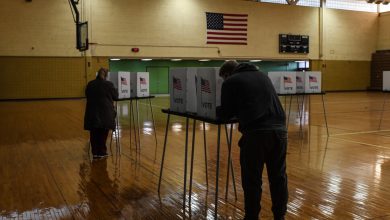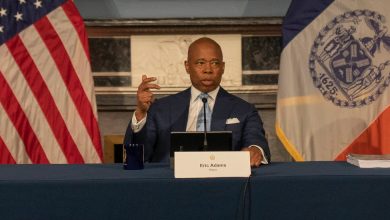Haunted by Guilt, Vilified Online: A Year After the Seoul Crowd Crush

Over Halloween weekend last year, nearly 160 young people died in a crowd crush in Itaewon, a popular nightlife district in Seoul. For those who survived or lost loved ones, the past year has been a time of deep frustration and trauma.
A government investigation failed to explain why desperate calls to the police were ignored for hours. Senior officials refused to take responsibility. The disaster quickly became politicized, dividing people — and quarreling political parties — over who should be held accountable. Many wrote online that the young victims and survivors should blame themselves. The survivors said they felt revictimized.
In December, Lee Jae-hyeon, 16, a survivor who had lost two of his best friends in the crowd crush, took his own life after battling online detractors of the victims. In a video message, he asked his parents not to blame themselves for his death.
“I wish that I would have parents like you in my next life,” he said.
As the first anniversary of the disaster approached, survivors and victims’ family members struggled with unanswered questions, missing their loved ones and at the same time deeply troubled by the government’s response.
Seo Byong-woo, 31, survivor
 Credit…
Credit…“I came out alive, but I could not save her although she was standing right next to me.”
The most haunting thing has been the sense of guilt among survivors and families who feel they failed to protect their friends and children.
Mr. Seo and his fiancée, Lee Joo-young, 28, became trapped in the crowd when they went for a stroll through Itaewon after visiting a wedding-dress shop. Waves of people pushed into a narrow alleyway from both ends, creating a deadly, suffocating pressure in the middle.
Walls of people pressed in from all sides, Mr. Seo said, leaving no wriggling or breathing space. In front of him, he saw stacks of people who had fallen on top of one another. “Move back! Move back!” people shouted, but nothing happened.
Mr. Seo passed out while standing. When he came to, he found Ms. Lee standing next to him unconscious, but there was nothing he could do to revive her.
He relives the nightmarish scene several times a day.
“The most difficult part is the sense of guilt,” Mr. Seo said. “I came out alive, but I could not save her although she was standing right next to me.”
Ms. Lee was a designer who created cartoon characters based on the cats, one black and one white, that she raised. She sold stickers, dolls, pouches and mugs bearing the cats’ image.
“She never failed to call me between 9 and 10 in the evening, when she was driving home after work,” Mr. Seo said. “I feel her absence when my phone no longer rings.”
Lee Jeong-min, 61, victim’s father
Mr. Lee — the father of Ms. Lee, Mr. Seo’s fiancée — has been campaigning with other victims’ families to persuade the country that official negligence was to blame for the disaster. But he has found the government of President Yoon Suk Yeol unwilling to acknowledge responsibility.
Park Geun-hye, the last president affiliated with Mr. Yoon’s governing People Power Party, saw her political fortunes crash after the sinking of the Sewol ferry in 2014. That disaster killed more than 300 people, most of them high school students. The victims’ families and their supporters helped organize enormous protests that eventually led to Ms. Park’s impeachment in 2017. Mr. Yoon’s party has moved to forestall similar public discontent after Itaewon.
“Yoon Suk Yeol feared he would become a second Park Geun-hye,” Mr. Lee said.
Victims’ families call the government’s investigation a whitewash because it never properly addressed what they say was official incompetence. No top official has been held accountable.
“The government has been ignoring us as if they wished we didn’t exist,” Mr. Lee said.
Kim Cho-rong, 33, survivor
 Credit…
Credit…“It appeared that our society dealt with a tragedy by spreading hate.”
For survivors, life has never been the same.
Ms. Kim, an author, suffered memory lapses and panic attacks. She sometimes struggled to go to the bathroom or to take the bus. Depression and suicidal impulses led her to seek psychiatric counseling.
Part of her depression stemmed from what she called South Korean society’s inability to “sympathize with the sufferings of other people” and its tendency to blame individuals in a disaster rather than to look into broader — and potentially embarrassing — structural causes.
People online called the young victims delinquent fun-seekers who should be responsible for their disorderliness when they followed Western customs like Halloween festivities. On a recent afternoon, a young mother and daughter walked past a white tent near Seoul City Hall, where mourners had paid tribute in front of photographs of Itaewon victims. When the girl asked who the people in the images were, the mother replied curtly, “That’s what would happen to you if you didn’t behave.”
Online, right-wing commenters vilified the families’ quest for accountability as a campaign to destabilize the government and seek more compensation. They showed up with loudspeakers at the families’ rallies, shouting that North Korea was behind the disaster.
“It appeared that our society dealt with a tragedy by spreading hate,” Ms. Kim said.
She has celebrated Halloween in Itaewon every year since 2016. All the festivities were held without major problems until last year. Ms. Kim went through her photographs from 2017, when more people gathered than there were last year. One picture showed Ms. Kim smiling in the same alleyway where the crowd crush would occur years later.
“That was when I realized that I did nothing wrong,” she said, “and that there was nothing wrong about going out to have fun.”
Lee Hyo-suk, 63, victim’s mother
Much of the country has moved on. But for the bereaved families, time remains frozen on the day their relatives died. One father said he cried for two days after a gift his daughter had ordered for his wedding anniversary arrived two weeks after her death.
Parents said they avoided gatherings of relatives because the absence of their children was more conspicuous and more painful. Some kept memories of their children alive by preserving how their bedrooms had been when they died.
“I miss my daughter the most when I lie in my bed,” said Lee Hyo-suk, whose daughter Jeong Ju-hee, 30, died in Itaewon. “When she came home, she used to lie next to me and talk.”
Ms. Lee said there was nothing she could do about her grief except visiting Ms. Jeong’s grave and banding together with other victims’ families. They console one another and fight for the truth about their children’s death to ensure that a similar tragedy will not happen again. With the support of opposition lawmakers, the families are pushing for a special law to start a new investigation that is independent of government influence.
“I had never imagined that this kind of disaster would happen to me,” Ms. Lee said. “Now I know that it could happen to anyone.”



